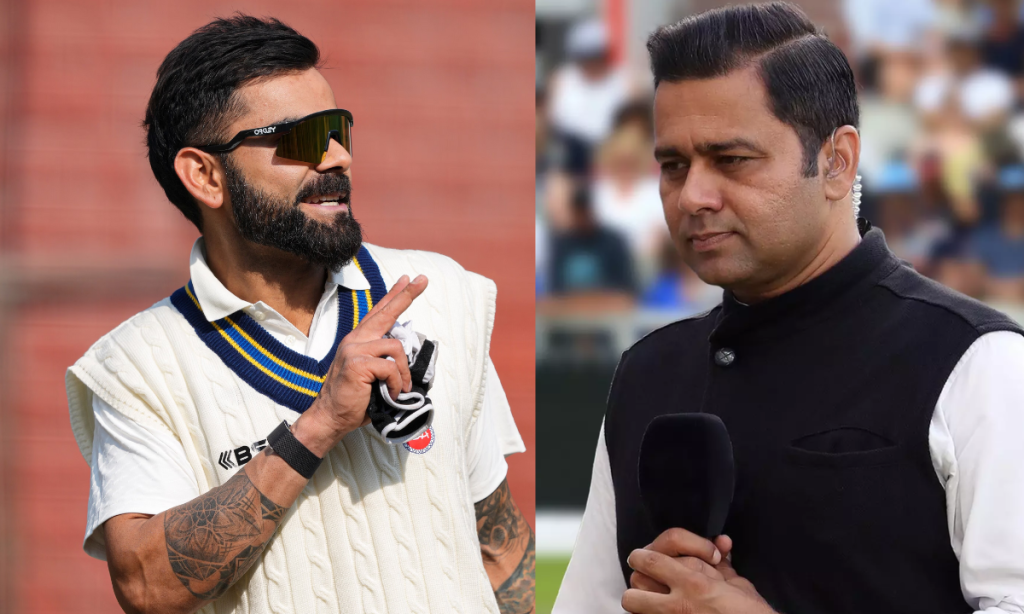In the realm of Indian cricket, the Ranji Trophy holds a prestigious position as the nation’s premier first-class cricket competition.
It’s a tournament that has historically been the breeding ground for cricketing talent, nurturing players who would go on to represent India at the highest levels.
However, recent trends, as highlighted by former Indian cricketer Aakash Chopra, have sparked a debate about the commitment of top-tier players to this domestic competition.
At the heart of this discussion is Virat Kohli, whose participation in a solitary match of the Ranji Trophy has raised questions about the motives and implications of such appearances.
The Context of Kohli’s Return
Virat Kohli, one of cricket’s modern icons, has returned to play a Ranji Trophy match for Delhi at the Arun Jaitley Stadium, a venue synonymous with his cricketing journey.
Earlier, Kohli was seen fine-tuning his skills in Alibaug under the guidance of Sanjay Bangar, particularly focusing on his back-foot play and handling deliveries outside the off-stump.
This preparation was not just about returning to domestic cricket but was seen as a strategic move to address specific weaknesses in his game.
Chopra noted, “Virat Kohli has become ready to play the game in Delhi. He was practicing with Sanjay Bangar earlier in Alibaug. He was trying to solve his back-foot and outside-off problems. So he has tried and now he is back at the Ranji Trophy level.”
This statement underscores the tactical aspect of Kohli’s participation, suggesting a personal quest for improvement rather than just fulfilling obligations.
The Token Appearance Phenomenon
However, Chopra’s critique extends beyond Kohli’s individual participation to a broader commentary on the engagement of all top Indian cricketers with domestic cricket.
He remarked, “He is playing but the others aren’t. Ultimately, everyone has done the token job. Virat had not played, so he is playing this match. Everyone else has marked their attendance.”
This observation paints a picture where elite players might be seen merely checking off a requirement rather than embracing the spirit of domestic cricket.
The term ‘punishment posting’ used by Chopra to describe these appearances is telling.
It implies that playing in the Ranji Trophy, for some, might not be a cherished opportunity but rather a compulsory detour from the high-octane international and IPL circuits.
Chopra emphasized, “It’s looking like a punishment posting. However, first-class cricket is not a punishment.”
Here, he defends the integrity and importance of first-class cricket, suggesting that it should be respected and valued, not treated as a mere formality.
Analyzing Performance and Commitment
Further delving into Kohli’s performance, Chopra highlighted a statistic that might concern fans and selectors alike.
“He has scored only 3 centuries in the last 5 years,” he said, pointing to a dip in Kohli’s scoring rate in Test cricket.
This statistic is particularly stark when compared to contemporaries like Steve Smith and Joe Root, who have maintained higher ‘strike rates’ of centuries per innings.
Chopra elaborated, “Smith has scored a century (against Sri Lanka). He has struck his 35th century in just 205 innings. Root has scored 36 hundreds but he has played 278 innings. So if you look at it in terms of the strike rate, the number of innings he takes to score a century, then Steve Smith is ahead of Joe Root. However, Kane Williamson has played only 186 innings and has scored 33 hundreds. His strike rate is better than those two.”
This comparison not only critiques Kohli’s output but also questions whether his occasional participation in domestic cricket is sufficient for maintaining or regaining peak form.
The Broader Implications
The discussion around Kohli’s and other players’ sporadic appearances in the Ranji Trophy touches on several broader issues in Indian cricket:
Player Development: The importance of domestic cricket for honing skills, especially for players in transitional phases of their careers, cannot be overstated. The absence of top players from regular domestic cricket might hinder their development and adaptation to different playing conditions.
Fan Expectations: Fans, who are the backbone of cricket in India, expect to see their stars in action, not just in international matches but also in domestic tournaments where they can witness the making of a cricketer.
Cultural Shift: There seems to be a cultural shift where the IPL and international cricket are prioritized, potentially devaluing the role of first-class cricket in a player’s career. This shift could lead to a dilution of traditional cricketing values where domestic cricket was seen as the ultimate proving ground.
Injury and Recovery: Playing domestic cricket can also be a strategic move for recovery from injuries or mental breaks from the intense international schedule. It offers a less pressured environment to regain form or fitness.
In Summary
Aakash Chopra’s comments on Virat Kohli and others playing single matches in the Ranji Trophy highlight a pivotal moment in Indian cricket.
It’s a call to reflect on how the cricketing ecosystem values its domestic competitions.
While it’s commendable that stars like Kohli are returning to their roots, the frequency and intent behind these appearances need scrutiny.
Is it about reinvigorating their game, or is it merely a nod to tradition without true commitment?
As cricket continues to evolve in India, ensuring that the Ranji Trophy remains a revered and integral part of a cricketer’s journey will be crucial.
The hope is that these appearances by top players are not just tokens but genuine steps towards a holistic approach to cricket development in the country.

